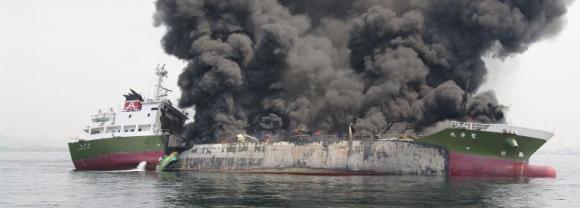
Photo:AFP
UPDATE: Between the effects of the explosion, fire, and water put aboard in firefighting the Shoko Maru subsequently sank.
The 2,242 DWT Japanese product tanker, Shoko Maru, exploded and caught fire Thursday morning, local time, while anchored about 5 kilometers off the port of Himeji in western Japan. The ship had recently finished discharging a cargo of heating oil. Seven of the eight ship’s crew escaped, although four were reported to be seriously burned. The rest were treated for lesser injuries. One person, reported to be the ship’s 64-year-old captain, is still missing.
It may at first seem counter-intuitive, but an empty tanker is far more likely to explode than a loaded tanker. While an empty tanker does not contain significant oil, the oil vapors left in the tanks when mixed with oxygen can form an explosive mixture which, if ignited by a spark, can go off like a bomb. There were unconfirmed reports that a sailor was using a grinder on deck just before the explosion. If this turns out to be accurate, a spark from the grinder may have set off the explosion.
Inert gas is used to prevent such explosions. In most cases, inert exhaust gases are scrubbed and injected into the tanks to displace the oxygen vapor mix. Inert gases from shore can also be used depending on the size of the ship. The requirement to use inert gas systems generally applies only to larger ships than the Shoko Maru. Until recently all new tank ships and most existing tank ships over 20,000 DWT were required to have installed and to use inert gas systems. Last year, the criteria was lowered to 8,000 DWT, which is still roughly four times larger than the just over 2,000 DWT Shoko Maru.
Japan Oil Tanker Shoko-Maru Explosion Leaves Four Hurt
Thanks to Phil Leon for contributing to this post.

It sang.
http://gcaptain.com/oil-tanker-explodes-japan/
After retiring from the Navy in ’76 I briefly worked for Jacksonville Shipyards. Whenever a ship was beginning a refit/repair there was a chemist taking readings to sniff for gases that might ignite. Until he gave the thumbs up no hot work of any kind could start.
Afrodite heads Up the Hudson Every 8 days Empty.
Because of her size, 53,000 DWT she has the
inert gas systems, and her empty tanks inerted.
Many years ago there was a ship in a lay-berth near Baltimore. An engineer was doing some repairs in the engine room on a cargo tank bilge pipe. His cutting torch lit a flammable mixture of oil vapor and oxygen in a bilge line which acted like a fuse and ignited vapor in a tank near the bow of the ship, blowing off a large section of the deck. The engineer didn’t know what he had done until someone from a shore trailer, who had a large piece of steel crash through their roof, came rushing aboard the ship asking what in hell was going on.